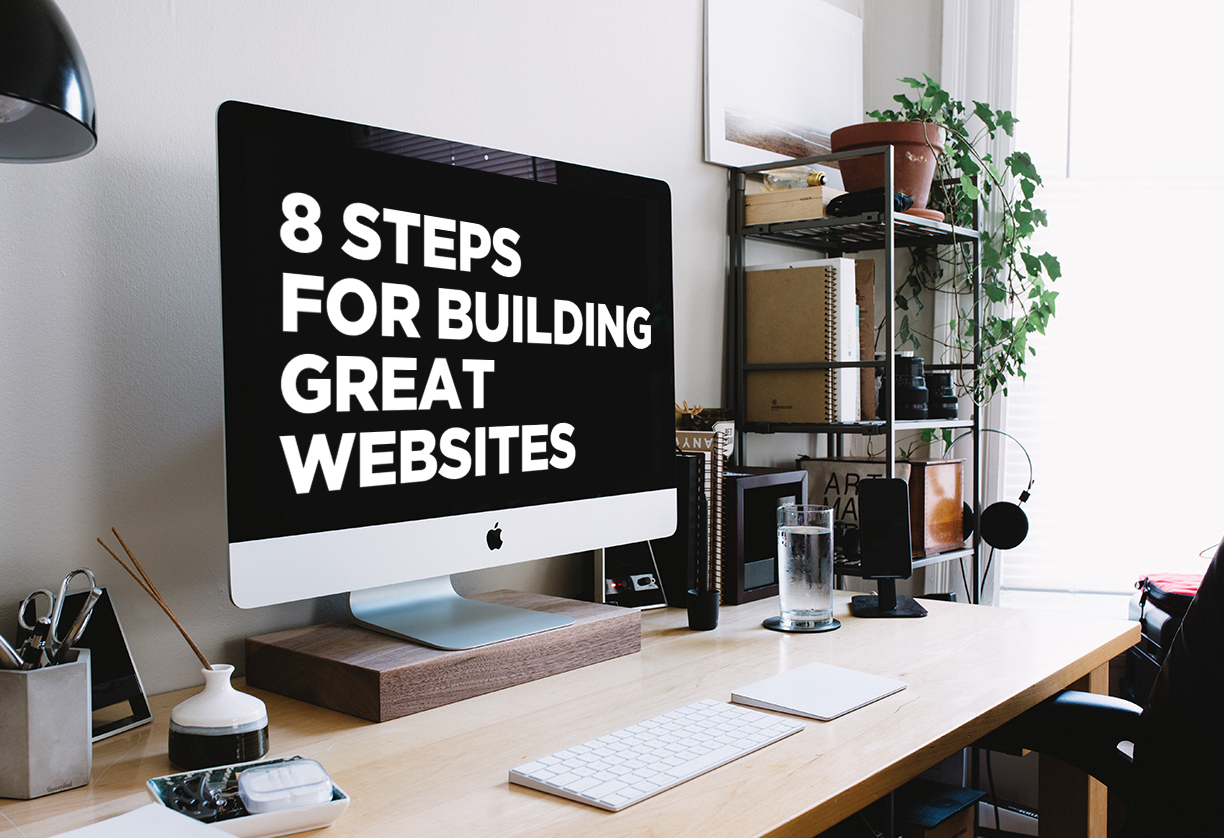A business website is arguably the most important marketing tool you have available to you. However, building a good website can be challenging. Back in the 90’s, we were building websites coded in HTML. There were no Google Analytics, barely any search engine optimization (SEO) and very few simple website content management systems (CMS) to purchase. Today, for building websites, we usually use WordPress, Squarespace or Shopify. While the CMS systems are “turnkey,” building an exceptional website takes a lot of effort. Even with the help from themes and templates; it takes time to plan, gather and organize the new or updated site’s details.
Here are 8 steps we take with clients to build great websites.
1) Identify the Goals
Before building a website, it’s important to understand the main objective of the website and the overall goals for the site. It’s critical to understand the target audience; who they are and why they need the site’s product or service. During this phase we help the client choose their domain name, the website CMS and hosting. We also explore answers to:
• How is our client different from competition? What does our client like/dislike about competitive websites?
• What are the biggest challenges in presenting the products/services?
• What primary call to action is needed?
Tip: We created an awesome questionnaire that covers these questions and more. Ask us for a copy and we will send it your way.
2) Create the Site Map, Gather Content
Create your content outline, or site map (flow chart). While there are several free apps or programs to use for site mapping, we save time by simply creating site maps in Google Sheets. We start by identifying the primary pages (overview pages) and then filling in the subpages (or second level pages) that contain more detail. After getting the client’s approval, we use the site map to identify all the content including:
• Existing and new copy
• Existing, new and/or stock photography
• Banners, videos, articles, documents, newsletters, blog posts, image galleries, team directories, RSS feeds, forums
• Other technologies needed (integrations, plugins, tools, etc.)
3) Complete the Wire Framing
Next, our designer can start wire frames (black and white line drawings of how the elements will be positioned on each page). When we create our wire frames we use “rule lines” to represent copy and boxes to depict images, banners, videos, etc. It’s important to think about everything needed on each page and then depict those items graphically. The wire frames are a great way to show the client how the content lays out before looking at real copy and images in place. Each unique web page needs its own wire frame (this includes contact pages, blog posts, service or product pages). The client should approve each wire frame.
4) Lay Out Each Page
Once wire frames have been approved, page layouts can be designed. Layouts should include Greek (placeholder) copy, and stock images as stand-ins for actual photography. This saves time and money, yet shows what the page will look like. These images can also serve as a “go by” for what the client should look for in their own photo library or use for guidance for new photography (also works like a photo shoot shot list). We complete a layout for every unique page. Usually layouts will number from 8 to 15 pages for an average size site. Layouts contain colors, logos, images and really demonstrate how the final website will look. During layouts, we also review the user experience with our creative team and the developer. If we make improvements, we can adjust the page layouts before showing the client. As always, the client gets time to review and provide feedback.
5) Write Content, Compile Final Assets
Writing the content and compiling the final assets for the site, often overlap with other steps in the website design process. Gather the written content into a document with separate pages for each page of the new site. Ideally, we are able to position final copy into the final layouts for approvals. In addition to content, each page must have some basic elements of SEO such as the exact page names, title tags, meta data and redirects. We create a separate early SEO document for the developer and arrange the information in accordance with the site map. Our SEO experts will update the SEO in the CMS before launch. We purchase stock images and gather any images provided by clients. Be sure your photos are sized accurately and identified for each page. It is also time to create a document that identifies the unique destination of each link on the site. Assemble any PDFs that are referenced on the site for uploading. Have all the logins for hosting, DNS, Google Analytics, integrations and other apps ready. With the content and assets ready, the kick off meeting with the web developer can take place.
6) Development
After the kick off meeting with the developer, the website build begins. The site is hosted and CMS is implemented on a development server. The home page is typically where development starts. Next, static pages are built, often in a methodical way aligned with the site map. Once created, the pages are tested for functionality. Special integrations and plugins are then added to the website. Once the entire website is built, our team reviews all the functionality, design elements, graphics, integrations and proofreads each page carefully and makes any corrections needed. A link to the development site is provided to the client for proofing. Most changes at the end of this stage are small, so we are able to move the website to the launch phase.
7) Test & Launch Website
Testing is a very important precursor to the website launch. Every link is tested, every online form is tested and all scripts are checked. Code is validated across all current web standards and browsers. Responsive code is tested. After checking and rechecking on the development site, the website files are uploaded to the hosting server. Once the files are deployed, we run more tests to ensure all the files have been installed properly. We also manually test the website across MAC, PC, various browsers, tablets and smartphones to ensure it is functioning properly.
8) Maintain the Site
Make sure you plan for maintaining your website. We offer a maintenance package after your site’s successful launch. With the use of a CMS, regular updates will need to be completed. Often the website updates will not align with the existing integrations and plugins so repairs may be needed. Most hosting companies provide back-up systems, but understand how often your website is backed up. It may be prudent to have a supplemental back-up system in place. Simple updates and changes may be implemented more easily by a professional developer versus someone that does not work in the CMS regularly. It is always an advantage to have trained professionals ready to quickly make updates or fixes for your site, because your site is a priority for them. Of course, maintenance is not just technical. Refreshing content often will help SEO.
To learn more about our 8 steps, or to get our help designing your new website, contact us.





